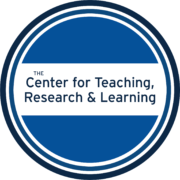Helping Students Connect the Liberal Arts to Life After College
A liberal arts education provides students with a wide range of knowledge and skills. However, our students don’t always understand how to articulate their skills to potential employers. In the course of your teaching, you have unique opportunities to call attention to some of the links between what’s happening in your class and the skills students might be expected to have post-graduation.
1. A liberal arts education prepares students well for life after AU.
When asked what undergraduate majors they favor in recruiting new hires, employers who recruit students at AU select “all majors” more often than any other option. This is because studying the liberal arts develops the skills employers most seek, namely
• oral communication
• written communication
• teamwork/ collaboration
• critical/ analytical thinking
• ethical decision making and problem solving
• applied technology/ quantitative skills
Source: “Falling Short? College learning and career success”, 2015 Hart Research Associates on behalf of the American Association of Colleges and Universities
2. You can help students connect what they are learning in your class to these highly desired competencies by incorporating them in the learning outcomes outlined on the syllabus.
Examples
• Students will be able to write policy memoranda comparing and analyzing various positions on political issues
• Students will develop presentation and communication skills through course discussion and making oral reports
• Students will learn to work as a team to design and present a unique business solution
• Students will acquire decision making skills by reviewing ethical dilemmas in peace and conflict resolution and presenting solutions in an academic paper
• Students will learn to analyze datasets using STATA and other tools and present scientific findings in a poster format
3. Throughout the semester, you can help your students see the connections between your assignments and the skills employers seek.
Doing so typically doesn’t require major changes to how or what you teach. Instead, try shifting the way you frame your discussion of the intention behind your assignments and the transferability of your course’s skills and content.
4. Oral communication skills are prevalent in many courses.
When your students complete assignments involving oral communication, you can point out the transferability of being able to succinctly and coherently speak their ideas. Oral communication activities include individual contributions to class discussion, interviewing research subjects, making classroom presentations, working in small groups, and participating in class debates.
5. Many courses rely extensively on written communication.
In addition to writing research papers, students can hone their writing skills through writing research proposals, journaling, blogging, and writing short essays and opinion pieces.
• The Writing Center has tips and resources for faculty
6. Critical thinking and analytical skills are vital for success in most classes – and careers.
In most courses, class discussions and written assignments provide opportunities to model and develop critical thinking and analytic skills. Again, point out when students are using and developing these skills in your courses. Often students neglect to reflect upon their own cognitive processes.
7. Where appropriate, create opportunities for collaboration and teamwork.
Asking students to reflect on their individual contributions and group dynamics can help students recognize the skills involved in successful collaborations. Promote collaboration and teamwork in multiple ways – from large group projects to small group discussions in the classroom. Check out these ideas from fellow AU faculty on how to successfully facilitate team projects:
• Ten Takeaways on Effective Group Projects
8. Demonstrate and encourage ethical decision making and problem solving skills.
Faculty can challenge students to address tough problems by bringing real world dilemmas into the classroom and having students consider and weigh multiple options. Not only can this tack support ethical problem solving, but it can also provide clear links between academic and professional spheres. Along the way, students will probably work on their critical thinking and communication skills, as well.
9. Share relevant technology for your field.
Your assignments that engage students with commonly used software tools such as SPSS, Excel, NVivo, WordPress, and Java help students to develop competencies that are valued in the workplace.
10. The Career Center has resources to support your teaching.
These include:
• In-class presentations that help students analyze an academic assignment (such as a capstone project) and learn to articulate how the project demonstrates the competencies employers seek. Email the Career Center to learn more.
• The Career Center’s Skills-to-Career Webpage. The site includes blogs from advisors and alumni, videos, and other resources to help our students understand the competencies most sought by employers.

